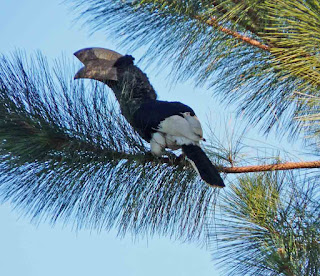November is drawing to a close so I thought I'd write a blog about the regular surveys I've been doing for the Tanzanian Bird Atlas project (http://tanzaniabirdatlas.com/).
The main survey is the daily log for the 500m radius circle around the house. Currently I have seen 117 species in this small area with an average of 87 species in each of the four months so far and 30-35 per day. The frequency of new birds added is slowing down considerably but in November I added Abdim's Stork, Wahlberg's Eagle, Red-headed Lovebird, Klaas's Cuckoo, Lesser Honeyguide, Rock Martin, Grosbeak Weaver and Golden-backed Weaver. November has seen a rapid increase in the amount of breeding behaviour around the house with all the weavers, the Firefinches, the Mannikins etc all busy building nests. The Blue Flycatchers that built a nest and began incubating in late October were thwarted by a ravenous pair of Tropical Boubous. They have moved on to try again elsewhere.
I've already described the fish factory beach. I've surveyed this twice now with a good range of migratory waders and other species like African Openbill, Hamerkop, Black Crake, Osprey, Spur-winged Lapwing, African Jacana, African Snipe, Grey-hooded Gull, Little Bee-eater, Grey-backed Fiscal and Western Yellow Wagtail. I've logged 37 species here with about 30 species on each visit.
A few km south of Bukoba is the Rubare Forest which is mainly a pine plantation with small patches of original forest where the ground was too rocky to plant pines. I've surveyed this three times now for a total of 32 species. Not many here and only an average of 16 on each visit but there are species here that are not likely to venture far from forests and there are so few patches of forest left in this part of Kagera. The highlights have been Blue Malkoha (aka Western Yellowbill), Yellow-rumped Tinkerbird, Black Cuckooshrike, Yellow-whiskered Greenbul, Grey-backed Camaroptera, Brown-crowned Tchagra, Collared, Olive-bellied and Western Olive Sunbirds and Black-necked Weaver. Every time I visit the forest I hear new calls but struggle to see the birds in the dense foliage.
The Ngono River survey has been the most productive to date. This was also described in an earlier blog post. I've surveyed here four times now for a total of 70 species and an average of 32 species per visit. It's a good spot for freshwater birds like Yellow-billed Ducks and Rufous-bellied Herons). This is also where we saw the Shoebill in October - one of Africa's truly special birds. The combination of open water, extensive reedbeds and rocky scrubland means a good range of species can be expected here. It also has the advantage of being largely devoid of people - unusual anywhere in Tanzania. Some of the other highlights here include: Squacco Heron, Osprey, Palm-nut Vulture, Black-chested Snake-Eagle, Eurasian and African Marsh Harriers, Long-toed Lapwing, Red-headed Lovebird, Malachite Kingfisher, Bearded Woodpecker, Black Roughwing, Dark-capped Yellow Warbler, Fan-tailed Widowbird, Black-bellied Seedcracker, African Firefinch, Fawn-breasted Waxbill and Pin-tailed Whydah (don't you just love some of the bird names?).
My newest survey site is at the Katoke Teacher Training College about an hour's drive south of Bukoba. This is a large residential college surrounded by eucalyptus plantations, hilly grassland and rocky scrub country with some remnant forest along the valleys. It is also a nice quiet area where I can work undisturbed. Friday last week was my first survey there and I saw 42 species in a couple of hours. Several others were unidentified due to time constraints and lack of a camera. I'll go back later this week for another survey earlier in the morning when birds are more active. Highlights from Friday's visit were Tambourine Dove, Lilac-breasted Roller, Black-and-white-casqued Hornbill, Spot-flanked and Double-toothed Barbets, Rufous-naped Lark, Sooty Chat, Eastern Olivaceous Warbler, Croaking Cisticola, Red-faced Crombec, Brown-crowned Tchagra and Copper Sunbird.
A few recent photos:
 |
| Pink-backed Pelicans with a Marabou Stork, Bukoba |
 |
| White-headed Saw-wing, Bukoba |
 |
| Black-backed Puffback, Bukoba |
 |
| Black-chested Snake-Eagle, Ngono River, Kagera |
 |
| Pin-tailed Whydah and Yellow-throated Longclaw, Ngono River, Kagera |
 |
| Black-headed Oriole, Bukoba |
 |
| Northern Brown-throated Weaver, Bukoba |
 |
| Black-and-white-casqued Hornbill, Bukoba (photo by Jenny Clark) |
 |
| Double-toothed Barbet, Bukoba |
 |
| Survey site adjacent to Katoke Teacher Training College |
 |
| Little Egret, Bukoba |
 |
| Bronze Mannikin, Bukoba |
 |
| Abdim's Stork, small sample of the 300 over our house recently, Bukoba |
Monday 29th November, Bukoba













You seem to love nature! it will never harm you, could you please provide the survey of 2011? i will keep waiting for the link!@bose
ReplyDeleteSample Survey
Every pic was serious eye candy and the Black chested Snake Eagle should have been still closer. i love photography! Questionnaire
ReplyDelete